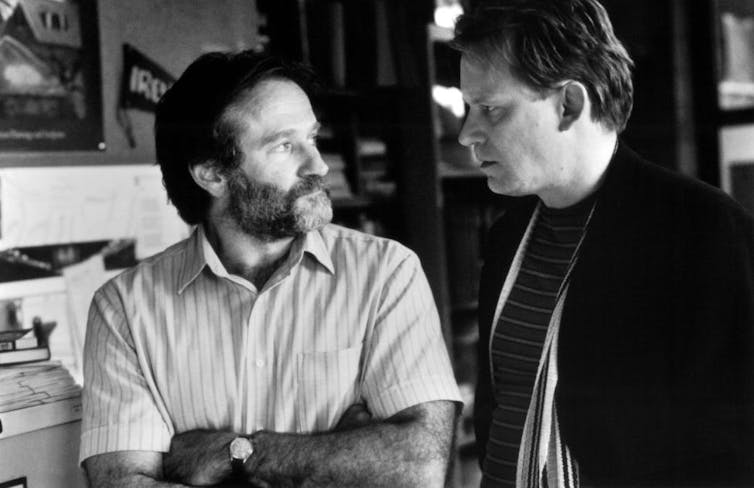When I read the recent New York Times article “Therapy Is Good. These Therapists Are Bad,” I couldn’t help but think of the Apple TV+ series “Shrinking.”
The article details the troubling prevalence of ethical and legal boundary violations by therapists: riding an exercise bike during appointments, bringing a dog into sessions despite a patient’s fear of animals, flirting with patients and even having sex with them.
In “Shrinking,” Jason Segel stars as Jimmy Laird, a cognitive behavioral therapist who becomes increasingly entangled in his patients’ lives. His skeptical boss, Paul Rhoades – played by Harrison Ford – critiques Jimmy’s unconventional methods while facing struggles of his own. Everyone seems enmeshed with everyone else’s personal and professional lives: A patient lives with Jimmy; Jimmy is sleeping with his colleague, Gaby; Paul secretly treats Jimmy’s daughter; Jimmy’s neighbor starts a business with Jimmy’s patient. (No one, thankfully, is sleeping with their patient.)
Whether in real life or on screen, something strange is happening with therapy: The line between therapist and friend seems to be blurring.
As a screenwriter who teaches a course on how to portray mental health on screen, I wonder: Are these depictions a reaction to earlier conceptions of therapists? Do they reflect a growing suspicion of authority? And what do they ultimately reveal about what we now want from a therapist?
The distant therapist
Not too long ago, therapists acted like black boxes and authoritative gods.
Take my father, a well-regarded, Freudian psychoanalyst who never shared anything about himself with his patients. He wanted to be a blank wall onto which the patient could project their fantasies.
He saw patients at our home. When they arrived or left, my family hid to preserve the client’s anonymity. When we were out running errands and saw one of his patients, we quickly left so the patient would have no inkling of my father’s personal life.
Keystone-France/Gamma-Keystone via Getty Images
Movies from the 1940s reflect the trope of the mysterious therapist. Dr. Jaquith in the 1942 film “Now, Voyager” is a friendly presence yet remains unknowable, even as he effectively cures his patient’s mental health issues.
Naturally, positive depictions of therapists gave rise to negative ones. Released that same year, “King’s Row” features a therapist, Dr. Tower, who seems to be a consummate professional, but ends up poisoning his disturbed daughter and killing himself, a twist that hints at an incestuous relationship between the two.
“Ordinary People,” which won best picture at the 1981 Academy Awards, tells the story of Conrad Jarrett, a teenager who has attempted suicide, and may be contemplating it again.
Dr. Berger, his therapist who’s played by Judd Hirsch, is friendly and empathetic, but still maintains professional boundaries. When Conrad asks how life can be worth living when it’s so painful, Berger’s comforting response – “Because I’m your friend” – is clearly a therapeutic technique, not a declaration of friendship.
Therapists are people, too
Later on-screen depictions of therapists humanize them as flawed individuals, just like everyone else.
In “Good Will Hunting,” Robin Williams’ Dr. Maguire grieves over his late wife and talks about his own mental health struggles.
Viewers are privy to the personal struggles of “The Sopranos” therapist Jennifer Melfi, played by Lorraine Bracco. While she occasionally missteps – like when she accidentally reveals Tony Soprano’s identity – she takes her job seriously and routinely consults a fellow therapist, which is part of the ongoing learning process for practitioners. She’s human yet professional.

Michael Ochs Archives/Getty Images
In “Shrinking,” however, the boundaries blur completely. The show’s messy web of care and connection is entertaining and funny. But it distorts the therapist’s role. Everyone involved – patient, family member, practitioner – is portrayed as equally flawed and equally responsible for each other’s growth. While the therapists in “Shrinking” make a lot of mistakes, the message seems to be that connection and shared vulnerability matter more than expertise.
In Season 2, “Shrinking” does interrogate its own boundary crossing when Jimmy realizes he can’t be a therapist, friend and roommate. And Paul starts out from a position of unmovable authority and realizes that he has his own issues – and that maybe Jimmy is a better therapist than he gives him credit for.
Finding a happy medium
But the gestalt – if I may use a psychological term – of “Shrinking” is that therapists and patients are on a somewhat equal footing and that boundary crossing is tolerated and even celebrated.
To me, this reflects a broader cultural shift away from trusting experts, which tangentially could be related to younger generations’ greater willingness to confront authority. Social media has blurred the lines between expertise and lay knowledge further, with influencers and celebrities sometimes positioning themselves as quasi-therapists.
At minimum, many patients nowadays seem to be looking for an equal, two-way conversation with their therapist, someone like Jimmy who admits that his psychological issues occasionally affect his therapeutic judgment.
This is in contrast to my father, who, at least publicly, resisted the notion that his own inner life might color his psychoanalytic interpretations. He saw himself as a scientist, uncovering the true objective source of a patient’s symptoms – an endeavor he believed could be tested with the rigor of a scientific hypothesis.
In my father’s defense, psychoanalysts are trained to recognize and neutralize their own psychological influence. He would say he was always learning. Still, his authoritative stance – and the continued insistence by many contemporary psychoanalysts on remaining a “blank screen” – may help explain why psychoanalysis has fallen out of favor as a therapeutic approach.
In the screenwriting classes I teach, I’ve shifted from positioning myself as an all-knowing expert to being a facilitator. I share my experience, including my mistakes and failures. But I mostly focus on helping students find their own answers. Similarly, therapy may need to balance expertise with authentic connection – say, a combination of Dr. Berger’s steady wisdom in “Ordinary People” with Dr. Maguire’s openness in “Good Will Hunting.”
If media depictions like “Shrinking” get you to talk about mental health or seek therapy, that’s no small thing. But I think it’s important to not conflate connection with qualification. Therapists aren’t friends. They’re trained professionals. And that boundary is exactly what makes the relationship work.

The post “Is a ‘friend-apist’ what we really want from therapy?” by David E. Tolchinsky, Professor and Dean, The Media School, Indiana University was published on 04/17/2025 by theconversation.com





































Leave a Reply